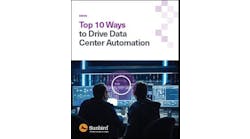7 Best Practices of Data Center Cable Management
Herman Chan, President of Sunbird Software, explores the ins and outs of data center cable management and how to streamline processes.
Herman Chan, President of Sunbird Software
Data center cable management is a complex task. Often considered a job only for network engineering, the fact is that improper cable management can spell trouble for the entire enterprise by leading to “spaghetti” cabinets, difficult equipment installations, and extended periods of troubleshooting and maintenance.
Poor cable management in the data center can cause unsafe environments due to restricted airflow to cabinets. And tracking all this on Excel spreadsheets becomes more and more challenging as rack densities and multi-hop connections increase. Because of this, many organizations are investing time and resources in the planning, implementation, and ongoing maintenance of their network infrastructure. Still, however, they struggle to address many of the key challenges of data center cable management.
Common Data Center Cable Management Challenges and Solutions
Although your challenges may vary, the following are some of the most common and can be addressed by instilling good behavior and sticking to best practices.
Data center cable management is often a difficult job for network engineers and data center managers alike due to issues such as “spaghetti” cabinets, poor documentation, and an inability to adjust to future changes.
- Designing the network or structured cabling infrastructure in advance. There is a lot to consider when designing a new network. Top/middle of rack switching or patching? Will structured cabling be used? Fiber or copper? A lot of thought needs to go into answering these questions. What quantity, port density, and bandwidth requirements of servers or other equipment will be installed into cabinets, how often will network capacity need to be added, and other factors unique to each data center environment will need to be considered. To help ensure a successful installation, designing the infrastructure early is critical. Using Data Center Infrastructure Management (DCIM) software to document the initial design enables real-time transparency of physical network capacity at every cabinet in the white space down to the individual port level. This dramatically simplifies planning for any connectivity requirements from new equipment being provisioned. With DCIM software tracking every physical connection, data center infrastructure managers can view in 3D virtual floor map visualizations to see the data center space, assets, and connections.
- Documenting all new patch cabling installations. Patch cabling documentation may seem easy to ignore, but poor documentation leads to difficulties maintaining and provisioning new equipment and troubleshooting connectivity issues. Documenting cable types, connectors, cabinet elevations, and the number of data and power ports is important to maintain uptime. DCIM software makes it easy to search, plan, provision, and document patch cable installations down to the port level by managing capacity and usage of in-rack patch and network switch port information. You can create a visual diagram showing which ports are in use on a device, use circuit trace diagrams to display each hop in a power or data circuit with details of each connection, and visualize connections between ports on a floor map.
- Determining the length of cable needed before installation. Accurately measuring cable lengths keeps your data center free of loose cables and helps keep costs down by reducing wasted cable but taking a tape measure to the data center floor is a time-consuming process. A comprehensive DCIM solution will do the work for you and help quickly measure with CAD-level accuracy not just the horizontal distance between cabinets, but the vertical distance from the device to the ceiling or floor. Having correct length cable runs will help avoid rework and downtime when changes are being implemented. It can even help save the environment by eliminating the waste of copper.
- Creating precise instructions for installation. The team doing the installation may not be the team who did the planning and design, and insufficient instructions in the build sheet can lead to incorrect installations and connections. Data center management software can help you create work orders based on cabling components and cabinet elevation information pulled directly from the software’s database. You can even print work orders with detailed information on the cable type and connector with clear port to port connection instructions.
- Validating connections. When planning and installing data center cables, it’s easy to focus on distances between starting and termination points and the amounts of cabling that you’re using. However, the compatibility of the physical connectors is just as important. You can’t provision new equipment to a rack without ensuring that that switch or patch panel has compatible ports. A complete DCIM solution will validate the compatibility of your connections before allowing you to make the planned move, add, or change. For example, when looking for the optimal locations to deploy new equipment, the software will not include cabinets without enough available compatible connectors. This dramatically improves productivity and efficiency.
- Tracking connectivity capacity with connectivity reports and dashboards. Most organizations today are making use of their big data to make smarter data center management decisions but knowing exactly which connectivity metrics to track is the key to have a holistic view of your network capacity, identify trends, and simplify equipment provisioning. Legacy tools such as Visio or Excel make it challenging to get actionable insights from your data, while a second-generation DCIM solution will provide business intelligence dashboards and zero-configuration analytics out-of-the-box to track your Key Performance Indicators without spending time on manual report building.
- Planning for the future. Modern data center environments are constantly changing. Provisioning new equipment used to take months, and now data center managers need to anticipate demand and be able to deploy resources at the speed of IT. Organizations that focus on the present rather than plan for the future will find it takes considerable time and effort to reconfigure what they have in order to implement what they need. DCIM software can help plan additions and decommissions for upcoming projects to limit their negative impact on network connectivity capacity before any changes are made. It can also reserve the resources that are planned for upcoming projects so you won’t accidentally allocate them elsewhere. These features can help you manage the impact of changes on your data center so you won’t need to worry about being unable to meet demand.
Untangle the Complexity of Data Center Cable Management with DCIM Software
Data center cable management is often a difficult job for network engineers and data center managers alike due to issues such as “spaghetti” cabinets, poor documentation, and an inability to adjust to future changes. However, knowing what the most common challenges are and how to approach them can make it faster and easier for you to efficiently troubleshoot and maintain your data center environment. Overcome the challenges of data center cabling with best practices and a modern DCIM solution, and you’ll be well on your way to driving sustainable behaviors that foster precise and accurate cable planning, installation, and management.
Herman Chan is the President of Sunbird Software.





